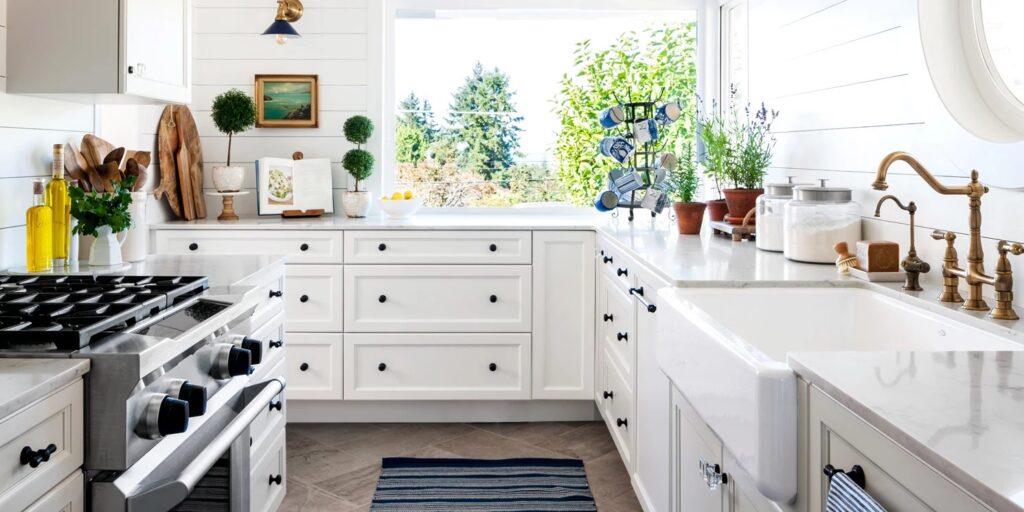Clean kitchen cabinets take a great deal of abuse, suffering unexpected spills, cooking splatters, and a continuous barrage of fingerprints. Yet those hardworking upper’s and lowers tend to get short shrift throughout routine weekly cleaning, so by the time you realize they have been neglected, grease, grime, dirt, and smears might have developed significantly.
How To Clean Kitchen Cabinets
In this article, you can know about clean kitchen cabinets here are the details below;
This is not simply undesirable: Oft-handled cabinet hardware can harbor germs, and food crumbs concealing in back corners can invite bugs and vermin. Plus, many kitchen cabinets are made of wood, a porous material that can end up being stubbornly sticky yet requires a gentler approach than you might use on metal or laminate.
Steps for Cleaning Kitchen Cabinets
To get those essential cabinets into pristine condition, follow this detailed guide– and make cleansing kitchen cabinets an open and shut case!
Step 1: Empty them out
You might opt to stagger cabinet cleansing instead of trying everything in one day since you’ll require eliminating and momentarily storing the contents on countertops or elsewhere.
– Once cabinets are empty, peel and dispose of past-its-prime shelf paper if essential.
– Vacuum or clean crumbs and dust from the shelves and drawers.
Step 2: Tackle the tops
When cabinets are not ceiling height, those few inches atop the uppers can be a significant mess magnet. Go at it on a strong step stool or ladder. If it’s simply dust, deal with it utilizing a long-handled duster or the small round brush accessory of a vacuum.
If grease has actually integrated with dust, removing it may be the nastiest part of your cabinet cleansing objective.
– Squirt the surface area with straight white vinegar, spray on some sodium bicarbonate, and provide it several minutes of dwell time.
– Scrub with a sponge, then scrape with a company straight edge, likes an old credit card, wiping off the gunk with a rag or paper towels.
– Spray once again gently and wipe dry with a clean cloth.
Step 3: Mix up a gentle cleanser
The objective is to clean, not damage, your cabinets.
– A few squirts of mild dish soap in hot water is an safe and effective formula to utilize on painted and ended up wood (along with metal, laminate, and vinyl). It will purge dirt, spots, and moderate grease accumulation; to provide the option of sterilizing oomph, include some white vinegar, which has antibacterial residential or commercial properties.
– To utilize: Mix in a spray bottle, but use onto a microfiber fabric or sponge rather than straight on the cabinet surface area, as it’s best to avoid saturating the wood.
Step 4: Clean high to low
– Start with the upper’s and work your way down. Do interior’s first: the back wall, then the side’s, then the shelves and drawers. Provide additional attention to corners, spritzing cleaning option on a toothbrush, and scrubbing carefully if needed.
– Follow with an cloth/sponge lightly moistened with plains water to remove any soap residue. Wipes dry completely after rinsing, then close the cabinets.
– Clean the sides of packages and do the doors/drawer fronts last.
Step 5: Go at the grease.
A moderate abrasive paste of one-part baking soda to two-parts water is a natural, economical weapon against sticky, yellowish grease accumulation that might work.
– Apply to stuck-on grease, let it permeate for several minutes, then scrub carefully (no scraping!) with a soft-bristled brush.
– Rinse with a damp rag, sponge, or microfiber cloth, then dry.
Suppose choosing to take on grease with a business product, area test initially on an inconspicuous location. Be particularly careful with magic erasers; these blocks of non-toxic melamine foam have the texture of super-fine sandpaper that can harm varnished wood and shiny paint surfaces.
Step 6: Treat the trim
Grease and dirt like crevices, so both are bound to settle in cabinet trim– the more elaborate, the cruddier it can become.
– Patiently purge with your basics cleaning solution and a soft toothbrush or fabric twisted around your forefinger.
– Rinse with an clean cloth moistened with plain water and dry.
Step 7: Handle hinges and hardware right.
Address metal elements of cabinets effectively.
– Wrap a dry fabric on your forefinger to clean the hinges. If you experience stubborn grease, spray a 50/50 water-white vinegar mix on an old soft toothbrush to scrub it off, then dry.
– Employ the toothbrush technique to metal or ceramic hardware, and the areas around these deal with knobs and pulls, all of which can build up gunk and grease.
Step 8: Get the glass gleaming.
– If you’ve got glass-fronted cabinet doors, utilize commercial glass cleaner or a homemade spray option of one cup of rubbing alcohol, one cup of water, and one tablespoon of whites vinegar on inner and outer panes.
Step 9: Clean the contents
– Before filling up racks and drawers, check the cookware, meals, food bundles, etc., to ensure that those products aren’t dirty or filthy. Even if whatever looks beautiful, providing the contents a swipe with a microfiber cloth will warrant it worthwhile returning to your sparkling tidy cabinets.

